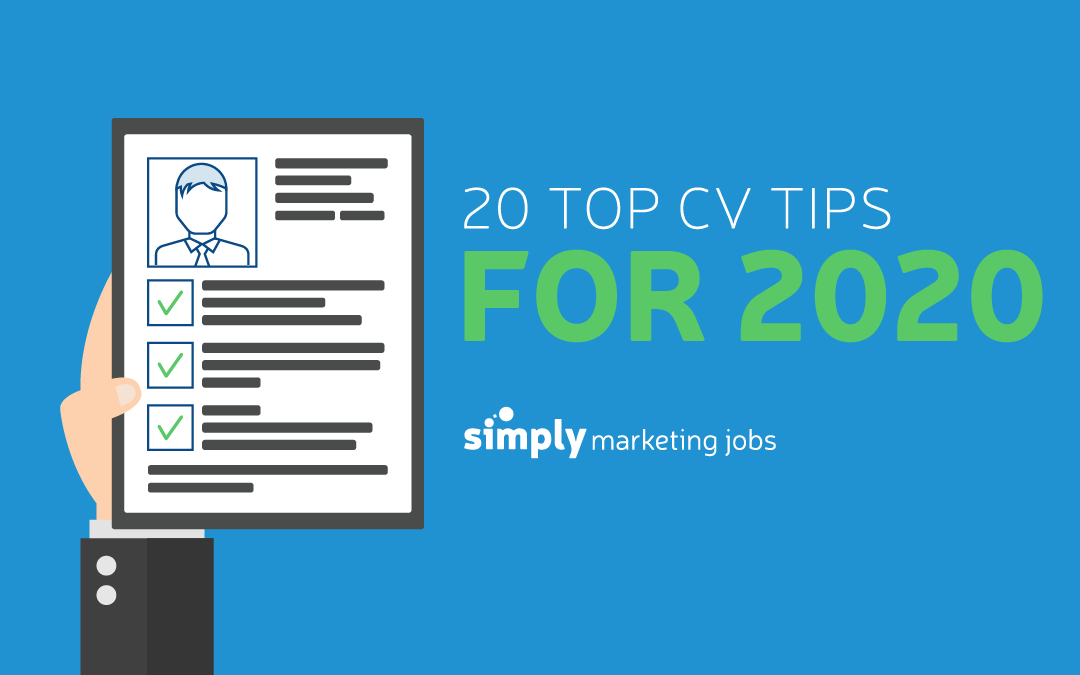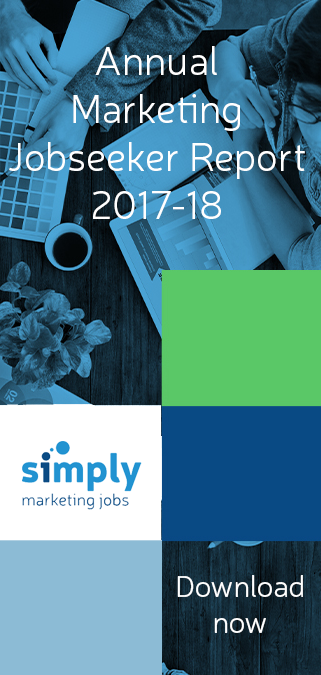January is almost here, and there’s probably a lot going on around you at the moment – festive parties have taken their toll, and now as your company prepares to tackle 2020 with a vengeance, you might be asking yourself if you still want to be in the same job for the remainder of the year.
In November, we ran a survey with jobseekers on our website, to find out if they were looking for a new job in 2020.
88% of professionals told us they were looking for a new job in 2020.
Maybe you’ve been looking at other jobs for a couple of weeks now – perhaps months? You may have been stretched too thin at the time to give your CV the attention it deserves. Maybe you’ve applied for a few jobs already, but haven’t heard back?
We talked alot about ways to improve your CV in 2019, so here are a few extra tips for 2020 that you might not have thought could affect employers considering your CV.
1. Your name, professional title and contact details
Do you start your CV with the title ‘Curriculum Vitae’? Well here’s your first 2020 resolution – remove it from all future CVs. Quite simply, it’s a waste of space when the context in which someone will look at it will be that you are applying for a job anyway.
Instead, have your name, professional title (if applicable) and your contact details right at the top, so they are the first thing a recruiter will see.
2. Be strategic with bold, caps and italics
Make your name and job title stand out amongst other details. They don’t need to be huge, or in different colours, but you may decide to make them slightly bigger, or bold them – making your name stand out makes you more memorable – otherwise it blends in to the rest of your CV. Whichever you choose to do, be consistent e.g. if you’ve made subheadings bold, make them all bold. If you’ve used bullet points in one section, make sure the next section uses them too.
3. Choose an attractive, readable font
Think that because it’s a CV it all has to be in Time New Roman? Wrong. While we’d highly recommend you avoid fonts like Comic Sans, choosing a slightly different font to the norm is another way to make your CV stand out. Just be you’re picking fonts that are easy to read. For example, Verdana, Arial or Helvetica. And yes, you should definitely avoid Curlz MT.
4. Balance your text and white space
Just like adding margins, and creating a tidy layout, balancing your text and white space makes your CV more aesthetically pleasing to the eye. Why? Because a document with too much white space looks…empty. Don’t sacrifice all of your white space though – it still needs to look presentable as opposed to looking busy.
5. Identify what format works best
If everyone has the same format for their CV, it probably makes the employer’s role as a recruiter very dull…but low and behold, here is one CV that really stands out from the rest! Why? Because you formatted it differently.
Now, we’re not saying to make a complete U-turn on what the ‘typical’ CV looks like, but there are ways that you can rejig it to look slightly different. This might include:
- Combination: This format involves putting your skills first. Skills generally tend to be a section recruiters value, as it tells them who you are as an individual in the workplace. If you are applying for an Account Management role which requires excellent communication skills, then presenting this within the skills section is ideal for a recruiter to see.
- Functional: While our research suggests that recruiters aren’t very fond of this format, if you have gaps in your CV, it could be the best option if you’re a stay-at-home mother returning to the workforce, for example. Some hiring managers see CVs like this as a red flag, so if you do go down this route, you have to make sure you can justify the gaps in your cover letter.
- Reverse chronological work experience – This makes it easy for employers to see the pattern you’ve followed in your career e.g. did you start as a Marketing Assistant and work your way up to becoming a Marketing Manager? Just make sure there are no gaps in your CV if you are using this format.
Another option that we have seen with graduates before, includes putting any work experience first (after contact details) to show that they have practical experience whilst being in education, which is admirable to many employers. The rest follows after this.
6. Consider the employer’s needs
If you think about the hundreds of CVs hiring managers have to power through, it’s natural to assume they won’t look at many of them for longer than 8 seconds – unless they see something they like. This would suggest that you don’t want your CV to be any longer than a page or two (double sided for ease) – so you should always have it in the back of your mind to make your CV as concise as possible.
7. Read the job description…and then read it again
According to zety.com, many of us are so geared up to start applying for the job that we may only skim over a job advert – more accurately, 76 seconds. Which is why hiring managers find that 50% of those who applied are unqualified for the job. Read it twice to make sure you are suitable for the role, and give it some thought. Is the location close enough/just right? What are the working hours like? What does it say about company culture? Don’t apply for a job because you are desperate to take the next step or find a new job. Think about whether it’s really a place or a role you could see yourself working in.
8. Link it all in
Today, it’s highly likely you won’t be handing your CV to an employer in person. So adapt your CV for the online world, and include links to professional social media profiles, portfolios or blogs you write for. Depending on your role, personal websites go down a real treat for potential employers – it shows them that you are passionate about something, and therefore willing to put in work to emphasise this. Even bigger props if that blog or website is applicable to the role you are applying for.
9. Match your cover letter to your CV
So your CV mentions that you are a creative thinker, but your cover letter doesn’t mention anything to back this up? An employer might pick up on this and feel something is missing…verification.
If you want to ensure you have a CV and cover letter that compliment each other, why not try writing your cover letter first, so that you can then break down your main points in to referenced bullet points in your work experience? That way, you’ve covered all areas important to the employer.
10. Be concise
Writing a CV isn’t like writing an essay. If your CV is longer than 1 or two pages, it’s likely you’ve included information that’s not necessary (which could lose the hiring manager’s attention). Rather than writing in full sentences (unless required) bullet point your work experience to give employers a quick snapshot of what you can do. This is the easiest way to cut redundant information out of your CV.
Remember, you don’t need to list every single responsibility you had at your current or previous roles. Simply list the skills and experience that demonstrate what you need to do the job you have applied for. A big tip is to list achievements too – facts and figures will go a long way with any hiring manager.
11. Redundant jargon
Following on from our previous point, nonsensical jargon can go too…
Working in the marketing industry means there is likely a fair amount of jargon you will use daily – but that doesn’t necessarily mean the person hiring you understands it. Use layman’s terms or simplified equivalents where you can to avoid any confusion about your CV.
12. Use the upper middle area of your CV to wow recruiters
The upper-middle area of the first page of your CV is known as the ‘CV hotspot’. This is where the eye naturally falls so think about including your most important experience or ‘key attributes’ here – for example, if you are applying for a Digital Marketing Manager role, this section might include any relevant work experience you’ve completed specifically in a management role in this area.
13. Use figures to get your point across
Bold statements about your achievements are great – but make sure you can back up what you’ve said. Figures come in really handy for this. Any figures that can justify the work you’ve done in your current role, include them. It gives the hiring manager an idea of how effective you could be at the company they represent.
14. Add achievements to your experience section
If you’re currently pioneering the way for tailored CVs, adding specific achievements to your experience section will boost your tailored CV through the roof. If you can illustrate a skill of responsibility with an achievement, it puts you two steps ahead of other candidates with the same skill set.
15. Tailor your CV to the job description
We talk a lot about this at Simply Marketing Jobs. That’s because your CV is your first opportunity to get your foot in the door. If recruiters can’t see the skills, experience or type of character they are looking for in your CV, it’s going straight towards the rejection section.
Need some help? Use our standout CV guide to get yours up to scratch.
16. Use tools and another person to proofread
You might consider yourself to be an excellent or poor proofreader. Whichever it is, we’d recommend you don’t take any chances in doing it yourself. Tools like Grammarly can proof your CV and provide suggestions on what should be changed. Getting a fresh pair of eyes in a friend or family member is also useful – you’d be surprised how much you could miss when you’ve spent so much time trying to perfect your CV.
17. Add a hobbies and interests section
Adding in this section shows employers you are human – that you socialise, and like to play in a team sport (so in their mind, you’re a team player?). Highlighting valuable interests and hobbies that compliment the skills relevant to your career will go down very well.
18. DO NOT LIE
It goes without saying, lying is not a great start when building a first impression. You must assume that everything on your CV will be further investigated by the hiring manager – and it could prove embarrassing in your interview if they pick up on it. It will cost you one job (maybe more), a career, and potentially a lawsuit, depending on how bad it is.
19. Write a thank you email
This isn’t one that gets mentioned too often, but it’s always great to acknowledge an interview after you’ve attended. Sending a post-interview thank you email is good etiquette – even if you think you aced the interview, saying thank you for even being considered is just polite.
20. Draw attention to any promotions
Any promotions you’ve received are essential to showing how you have progressed in your career. Under each company, section off each job role you have had there, particularly if it’s due to a promotion. For example:
Cutters PR agency – Digital Marketing Manager
- Participated in team leader training
- Created and executed marketing strategy for a number of clients
- Quick turnaround on ordering merchandise with a cost effective approach
- Improved Google Adwords ROI by 104% and achieved top organic rankings for keywords
- Pioneered social media activity within the company, including PPC
- Developed engaging blog content including industry news, marketing advice for clients
- Created engaging videos via Biteable
- Published eye-catching content via WordPress est driving and identifying vehicle faults
Want more advice for your CV? Download our CV guide below!
10 tips for a top cover letter
A cover letter accompanies your CV when you apply for a job. The letter is designed to act as a short introduction to you and your expertise. It should be your pitch to encourage an employer to consider your CV. A cover letter should be professional and...
How to answer: “Why are you leaving your current job?”
In any interview, your interviewer is going to want to know why you want the role. This usually involves finding out why you are leaving your current job. This is a relevant question if you are currently employed or if you left your previous role some time...
How to answer “What can you bring to the role?”
While there are a number of questions you should be prepared to answer for your job interview, there are some that can prove trickier than others. One of those is: "What can you bring to the role?"You might be scratching your head thinking, "me?" but of...






